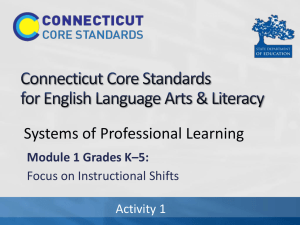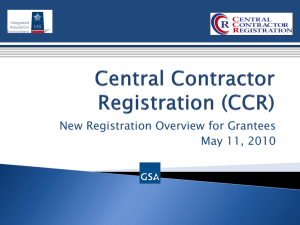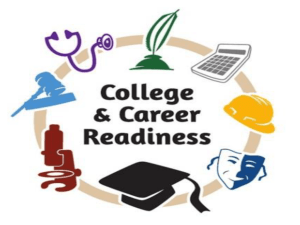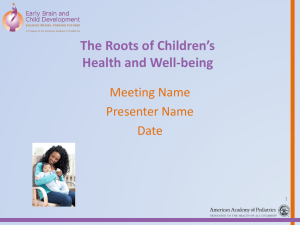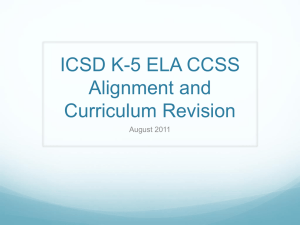Child Care Resource and Referral (CCR&R)
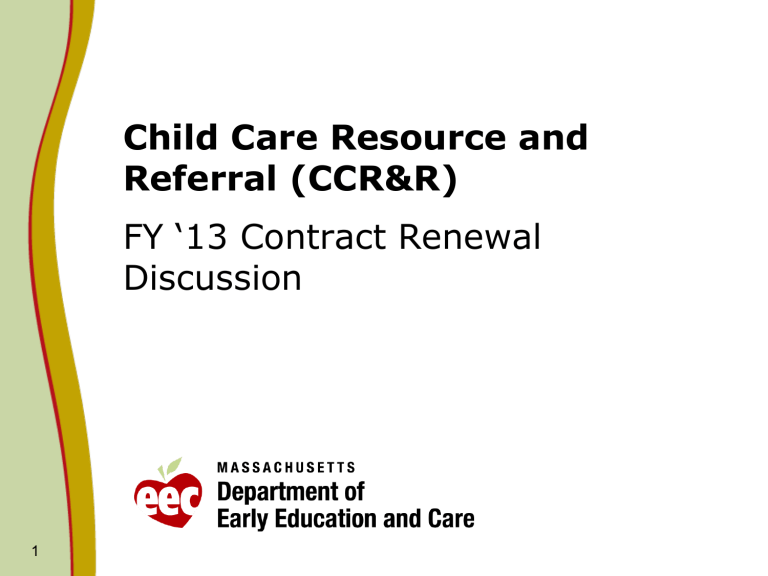
1
Child Care Resource and
Referral (CCR&R)
FY ‘13 Contract Renewal
Discussion
2
History of CCR&Rs in Massachusetts
In the 1970s Massachusetts was one of the first states to develop information and referral services to support working families needing to find child care for their children. They tracked supply and demand data and worked with both the child care providers and the state
to improve quality and access for all families.
Throughout those early years and into the mid-1990s, the core child care resource and referral services were:
Consumer education including information and referral,
Training and technical assistance for providers,
Resource development,
Data collection and analyses, and
Policy and advocacy.
Source: The CAYL Institute Child Care Resource and Referral Study Circle Project May 2011
3
History of CCR&Rs in Massachusetts
In the 1980s, two major changes took place that impacted the child care resource and referral field in
Massachusetts:
First: The state merged CCR&Rs with Voucher
Management Agencies (VMAs).
Second: Employer-supported resource and referral services expanded across the country via
Work Family Directions.
Both were a mixed blessing for the CCR&Rs. Many
benefited from the contract dollars with corporations and served a wide array of working families. Simultaneously, voucher management began to shift the role of the CCR&Rs by expanding their focus to serving primarily the lowest
income families and managing vouchers.
Source: The CAYL Institute Child Care Resource and Referral Study Circle Project May 2011
4
History of CCR&Rs in Massachusetts
In the mid-1990s:
With the passing of welfare reform at both at the state and then federal levels, the CCR&Rs
voucher management role expanded, becoming almost their sole focus.
Simultaneously, Work Family Directions pulled
back many of the contracts that had once provided private funding to the agencies, making the agencies’ resources very tight for supporting moderate income working families.
In 2009 CCR&RRs lost $ in 9c funding cuts.
Source:The CAYL Institute Child Care Resource and Referral Study Circle Project May 2011
5
CCR&Rs Today
In 2009, the CCR&R contract was put out to bid resulting in the three-year contracts that began on 7/1/10.
As a result of the bid, the number of
CCR&Rs decreased from 14 to 11.
A new contracting structure was put in place with contract for 3 levels:
Level 1: Voucher Management
Level 2: Information and Referral
Level 3: State-wide consumer information
6
CCR&Rs Today
The breakdown in levels of service offered is the following:
3 CCR&Rs offer Level One only (Voucher Management)
2 CCR&Rs offer only Level Two (Information and Referral)
6 CCR&Rs offer Level One and Two combined
2 CCR&Rs also offer Level 3 (Enhanced Consumer
Education.)
7
Overlap with other EEC Funding:
Of the 11 CCR&Rs:
2 Are the Lead CFCE Grantee
• 2 Subcontract with a local CFCE
3 are the lead EPS grantee
• 6 are members of the EPS Network
Team in their region (2 have subcontracts.)
0 are affiliated with a parent agency that also receives the EC Mental
Health grant.
8
FY 11 ARRA Funding
In FY 11 CCR&Rs received $561K in ARRA funding to support:
the transition to their new contracts,
Implementation of efficiencies, and enrolling children in ARRA funded initiatives.
CCR&Rs used these funds:
To fund 22 FTEs to fill gaps in staffing,
Pay for overtime to handle ARRA intake,
For the addition of new telephone lines, updated websites and scheduling software.
With the termination of these funds many
CCR&Rs have returned to lower staff levels.
9
CCR&R
10
11
12
Contract Requirements include:
Level One: Subsidy Management:
Voucher Management: Determine family eligibility for entry and renewal of services per EEC Subsidy Policy.
Family Support: Meet with families to begin/renew child care subsidy.
Collaboration: with other agencies to support enrollment/continuation of eligible services.
Documentation/recording required:
Billing and Provider Reimbursement
Provider Monitoring
13
CCR&Rs and Voucher Management:
CCR&R Statewide New Voucher Placement and
Reassessments*
16 000
14 269
14 000
1 567
12 000
10 000
8 000
6 000
12 702
7 886
8 171
8 232
1 265 1 594 965
9 924
1 193
7 439
890
4 000
8 731
6 906 6 638 6 921
6 549
2 000
7 921 7 793
769 652
9 052
666
11 227
711
9 258
665
7 152 7 141
8 386
10 516
8 593
9 695
703
11 328
1 103
8 992
10 225
6 290
756
5 534
9 178
964
8 213
0
CCR&R Statewide Reassessment - Start Placement CCR&R Statewide New Voucher Placement CCR&R Statewide Grand Total
*These numbers represent the volume of new (blue) and reassessed (red) vouchers written state-wide each month. These numbers do not capture no-show appointments or appointments held for vouchers not written due to insufficient documentation. Source: CCIMS
14
CCR&Rs and Voucher Management:
CCR&R New Voucher Placement by Child Care Account:
September 2010 – October 2011
1 800
1 600
1 567
95
1 400
1 200
444
1 265
231
1 000
800
600
1 023
400
200
288
746
1 594
113
721
755
1 193
0
965
1
483
529
890
0
266
480
663
623
769
737
652
612
666
629
711
644
665
595
703
654
1 103
0
155
948
756
713
34
244
701
980
0 5 0 5 1 1 1 2 0 1 1 1 0 0 0 1
9/1/2010 10/1/2010 11/1/2010 12/1/2010 1/1/2011 2/1/2011 3/1/2011 4/1/2011 5/1/2011 6/1/2011 7/1/2011 8/1/2011 9/1/2011 10/1/2011 Avg 9/10-
10/11
DSS DTA Income Eligible ARRA Grand Total
Standard Deviation: DSS: 2 ; DTA: 136; Income Eligible: 221; ARRA: 66 Grand Total: 318
Avg. = Average (9/10 – 10/11)
*September 2009 New Voucher Placement number was 1,736
*October 2009 New Voucher Placement number was 982
Source: CCIMS
15
Information and Referral Services
Level One: For subsidized families,
Level Two: all families
Respond to inquiries regarding options for early education and care services.
Needs assessment:
Act as a resource for identifying family needs, determining appropriate community resources and referring families to the appropriate services.
Information and referral service provision, allowed options for implementation:
Web-based,
State-wide telephone coverage,
Face-to-face Services,
Partnerships with other agencies (TANF, DTA, DCF,
DPH/EI.)
Other: Brochures, flyers, booklets, faxes, yellow pages, radio, tv, web videos, etc.
16
Contract Requirements include:
Level Three: Enhanced Consumer
Education. Provide innovative
communication models for state-wide dissemination of relevant info to families regarding early education and care, its importance for their children and their role as their children’s first educators.
17
FY ‘11 CCR&R Contract Performance Data
Number of outpost locations: 29
Number of families that received a Level Two referral: 16, 244
Ave number of appointments held per week during traditional hours: 1,333
Ave wait time to get an appointment: 1 week
Number of languages other than English spoken by CCR&R staff: 17
Number of families that received an
Orientation to in-home/relative care: 821
Ave Caseload per voucher counselor: 676
Percent NACCRA Quality Assured 60%
Activity
FY’12 First Quarter Reports:
FY 12
Plan
FY12
Actual
Balance
Outpost Locations
Goal for average wait time
Number of families to receive a referral
29
4 days 5 days Over target by average of 1 day
Ave Caseload per voucher Counselor 795
29
10,809 2,360
868
On target
22% of goal met in first quarter
Above target by average of
84 cases
Total new voucher agreements to be signed
458 125 27% of target met in first quarter
Number families to receive inhome/relative orientation
Total number of families to receive a
746 192 26% of target met in first quarter
16,510 2,820 17% of target met in first quarter
19
FY12 First Quarter Report, Level 3:
Resources Made Available: Number of
Items
CCR&R website
Tweets sent
Facebook posts
Events listed
Resources distributed
(newsletters & brochures)
Parent resources accessed
Webinars
Training videos
Resource links
Provider resources accessed
Webinars
Training clips
Resource links
5
7
24
4
6
32 http://machildcareresour cesonline.org/
17
54
83
9
Number of
Individuals
Reached
113,062 visitors
6,175
5,570
49,875
2,147
2,214
20
National Association of Child Care Resource and Referral Agencies (NACCRRA)
In November 2011, EEC contracted with NACCRA to build upon the CAYL report and EEC’s Strategic Plan to develop a plan for the improvement of CCR&R services in
Massachusetts.
The PROCESS underway includes:
Oct: Reviewed documents provided by EEC (CAYL
Study, EEC Race to the Top submission, Head Start
Survey Report, etc)
Nov: Focus groups held with parents, providers,
CCR&R staff, MASS 211, MADCA
Reviewed CCR&R best practice nation wide
Nov. /Early Dec. – Draft findings and initial recommendations to EEC
Presentation to EEC Board 12/13/11
Final report to EEC Jan 2012.
21
NACCRRA Plan for Massachusetts
Initial findings to date:
CCR&R agencies in Massachusetts do not meet national definition for service delivery and best practice standards for CCR&R,
Recruitment, training, professional development and oversight of child care providers is fragmented,
No standard definitions and measurable outcomes for services offered,
Voucher Management is labor intensive, paper laden and vulnerable to fraud,
Massachusetts is lagging behind in the use of technology in all areas of service delivery,
Access to family services for ALL families is confusing and disjointed,
22
NACCRRA Plan for Massachusetts
Preliminary Recommendations
Adopt NACCRRA’s definition of CCR&R:
• An organization whose stated purpose includes delivery of information-based services to families, child care providers and the community.
• Organizations that provide services to only one of the target areas, but are part of a formal system of organizations that together provide all of the services to meet the definition of a CCR&R.
• The core services include at a minimum:
• Supporting all families;
• Active operation of referral and consumer education services;
• Supporting professional development;
• Increasing the availability, affordability and quality of child care;
• Supporting development of policies on family and children’s issues;
• Generating additional resources;
• Maintaining a high quality comprehensive database for the effective delivery of core services.
Currently, CCR&Rs in MA perform some, but not all of these functions.
23
NACCRA Plan for Massachusetts
Preliminary Recommendations
Adopt a managing network model through a competitive bid process. The selected agency should be centrally located, have the capacity to manage multiple projects, manage statewide data bases and use technology such as social media. It must also have a solid governance structure that does not include agencies or personnel with a clear conflict of interest.
Consolidate all information and referral activities for all families through a single statewide call center and web-site.
Ensure selected agency becomes Quality Assured
Region al/local
CCR&R office
Region al/local
CCR&R office
State Child
Care
Administrator
Region al/local
CCR&R office
CCR&R
Managing
Network
Office
Region al/local
CCR&R office
Managing Network Office
Functions:
-Primary Liaison with State ECE
-Manage and distribute CCR&R funding for the State Child Care Administrator
-Determine the range of services local
CCR&Rs should provide
-Develop and carry out contracts
-Consolidate all information and referral activities
-Track CCR&Rs’ performance through evaluation and quality assurance activities – single statewide call center and web-site
-Manage subsidy administration
-All agencies must be Quality Assured
Region al/local
CCR&R office
Region al/local
CCR&R office
Regional/Local CCR&R
Office Functions:
-Training
-Provider Support Services
-Provider Database
-QRIS Implementation:
-on-site technical assistance
25
NACCRRA Plan for Massachusetts
Preliminary Recommendations
Create a single state-wide, web-based database of all early care and education programs including child care, pre-k and Head Start programs.
Adopt a web-based subsidy management system that allows both parent and child care providers to input and update data on-line and allows them to track the status of their applications and other relevant information.
Establish a single web-based training and technical assistance tracking system that shares data with the state professional registry and allows for transfer of training within the state.
26
NACCRRA Plan for Massachusetts
Next steps:
Draft report and briefing to EEC for first review by Dec 23.
EEC to review draft report and provide comments to NACCRRA by
Dec 29.
Final report to EEC for Jan Board meeting by Jan 5.
27
Meanwhile, Changes are Underway:
Within their current contract, CCR&Rs have agreed to:
Become NACCRA Quality Assured. All Level 2 CCR&Rs are currently in the Self-Study process.
Support role-out of the voucher management pilot and subsequent expansion.
Increase their role in informing families and programs about the value of the QRIS.
Increase Level 3 outputs.
Update and streamline the process for monitoring voucher providers.
Enhance use of technology as possible with current funding.
Collaborate with MASS211 in delivery of information and referral services.
Develop a state-wide Advisory with broad representation.
28
Contract Renewal/Rebid Issues for
Consideration:
If implementation of NACCRRA recommendations represent a substantial change to current CCR&R contracts, rebidding may be required.
If rebid, EEC will need to purchase a redefined level of service and consider the CCR&R relationship to other grants.
Geography and integration with other funding sources will need consideration.
The impact on families and their needed access to subsidy must be kept in mind as any transition to a new system unfolds.
EEC may consider roll-out of changes in stages.
A process for informing and gathering feedback from the field will be developed .
